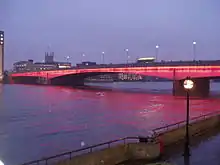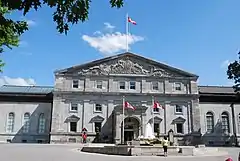Operation London Bridge
Operation London Bridge has been a codename that referred to the plan for what will happen in the days after the death of Queen Elizabeth II of the United Kingdom and the other Commonwealth realms. The plan was originally devised in the 1960s and is updated several times each year. It involves planning from government departments, the Church of England, Metropolitan Police Service, the British Armed Forces, the media, the Royal Parks, London boroughs, the Greater London Authority and Transport for London. Some critical decisions relating to the plan were made by the Queen herself, although some can only be made by her successor (the current heir apparent is her son, Charles, Prince of Wales), after her death.
| Operation London Bridge | |
|---|---|
| Part of actions to be taken on the death of Queen Elizabeth II | |
 London Bridge, the plan's namesake. |
As of early 2017, the phrase "London Bridge is down" was expected to be used to communicate the death of the Queen to the prime minister of the United Kingdom and key personnel, setting the plan into motion.
The codename Operation London Bridge primarily refers to events that would take place in the United Kingdom. In addition to the United Kingdom, other Commonwealth realms where Elizabeth II acts as monarch have developed their own plans for what will happen in the days after her death. These corresponding plans would run concurrently with Operation London Bridge.
Background
Funerals and coronations for the Royal Household are typically organised by the Earl Marshal and the officers in the College of Heralds.[1] Pre-determined phrases have typically been used as "codenames" for plans relating to the death and funeral of a royal family member. Initially, codenames were used by key officials in an effort to prevent Buckingham Palace switchboard operators from learning of the death prior to a public announcement.[2][3] When King George VI died in 1952, key government officials were informed with the phrase "Hyde Park Corner".[2]
Several codenamed funeral plans for royal family members in the late-20th and early 21st century have used the names of prominent bridges in the United Kingdom. Operation Tay Bridge was the phrase used for the death and funeral plans of Queen Elizabeth The Queen Mother, and was rehearsed for 22 years before its eventual use in 2002.[4] The funeral plan for Diana, Princess of Wales, was also modelled after Operation Tay Bridge.[2][4] As of early 2017, the phrase Operation Forth Bridge referred to funeral plans for Prince Philip, Duke of Edinburgh;[2] Operation Menai Bridge referred to the funeral plan for Charles, Prince of Wales;[5] and Operation London Bridge referred to the funeral plan for Queen Elizabeth II.[6][7]
Plan
.jpg.webp)

The Queen's private secretary will be the first official (i.e., not one of the Queen's relatives or part of a medical team) to convey the news. Their first act will be to contact the prime minister, where civil servants will convey the code phrase "London Bridge is down" to the prime minister using secure telephone lines.[2] The Foreign and Commonwealth Office's Global Response Centre, based at a secret location in London, will communicate the news to the governments of the fifteen other countries of which the Queen was the head of state (the Commonwealth realms), and to the governments of the other countries of the Commonwealth of Nations.[2]
The media would be informed via an announcement to PA Media (formerly known as the Press Association) and the British Broadcasting Corporation (BBC) through the Radio Alert Transmission System (RATS) and to commercial radio on the Independent Radio News through a network of blue "obit lights" which will alert presenters to play "inoffensive music" and prepare for a news flash, while BBC Two would suspend scheduled programming and switch to BBC One's broadcast of the announcement.[8] BBC News will air a pre-recorded sequence of portraits, during which the presenters on duty at the time will prepare for the formal announcement by putting on dark clothing prepared for this purpose. The Guardian has reported that The Times has eleven days of prepared coverage ready and that ITN and Sky News have long rehearsed her death, but substituting the name "Mrs Robinson".[2]
The moment after the Queen's death, the heir to the throne would immediately become the monarch, and although not crowned, they would still be addressed as the new sovereign. While the new monarch may choose to adopt their first baptismal name as their regnal name, they may also elect to chose a different regnal name; as any new monarch that comes to the throne has the right to choose their regnal name. In their first act as the new monarch, they will go on a tour of the United Kingdom, including London and Belfast.
A footman would pin a dark-edged notice to the gates of Buckingham Palace. At the same time, the palace website would display the same notice.[2] The Parliament of the United Kingdom would be recalled. If possible, it would meet within hours, and the prime minister would address the House of Commons. Local government buildings will fly flags at half-mast and books of condolence may be opened; ceremonial ornaments, such as ceremonial maces or council chains, are to be put in black purses.[9]
The day after the Queen's death, the Accession Council would meet at St James's Palace to proclaim the new monarch.[10][2] Parliament would meet that evening when MPs would swear allegiance to the new monarch.
Different arrangements for moving the Queen's coffin are planned depending on where she dies. For example, if the Queen dies at Windsor Castle or Sandringham House, it would be moved by car to Buckingham Palace within a couple of days. If the Queen dies overseas, it would be brought by No. 32 (The Royal) Squadron to RAF Northolt and then by car to Buckingham Palace. If the Queen dies in Scotland (for example, at Holyrood Palace or Balmoral Castle), the coffin would first lie in repose at Holyrood Palace followed by a service of reception at St Giles' Cathedral in Edinburgh. Following this, the coffin would then be transported to Waverley Station and then taken by the Royal Train to London.[11] In all cases, the coffin would be taken to the Throne Room at Buckingham Palace. Four days after the Queen's death, it would be moved to Westminster Hall and lie in state for four days.
The state funeral would be held at Westminster Abbey nine days after the Queen's death, after which her body would be buried in a prepared tomb at St George's Chapel, Windsor Castle.[2]
Corresponding plans
Officials from Buckingham Palace and Clarence House, known as the Inter-Realm Working Group, have briefed representatives of the Commonwealth realms about the funeral, and succession plans surrounding Operation London Bridge.[12] The governments of the Commonwealth realms will be informed of the death of the monarch from the Foreign and Commonwealth Office's Global Response Centre.[2] These realms have devised their own plans for what will happen in their respective countries in the days after Elizabeth II's death, which would run concurrently with Operation London Bridge.
Australia
After the government receives the news, a flag notice will be issued instructing flags to fly at half-mast immediately for the next ten days, except on the day the ascension of the new monarch is proclaimed.[12] After the death of the monarch of Australia, it is expected that the Parliament will meet for a condolence motion.[12] A speech has been drafted for the prime minister.[12] Current plans will see the governor-general of Australia issue the Australian proclamation of the accession of a new monarch at an appropriate ceremony.[12]
The Australian Defence Force will organise several gun salutes coinciding with events in London, and will participate in ceremonies in the United Kingdom.[12] The Australian High Commissioner to the United Kingdom is expected to observe the Accession Council. In addition, Australian members of the Privy Council of the United Kingdom are entitled to sit on the Accession Council.[12]
Canada
In Canada, preparations were made as early as 2002, during the Queen's Golden Jubilee.[13] Consultations over the plans have been made with the Canadian Armed Forces, the Canadian Privy Council Office, the Canadian secretary to the Queen, the office of the governor general of Canada, and the office of the Earl Marshal in the United Kingdom.[14] In addition to the federal government, provincial governments have also implemented their own contingency plans for the death of the Queen, and the ascension of a new monarch.[15]

After receiving news of the death of the Queen, it is the governor general's responsibility to recall the Cabinet to Parliament Hill and proclaim that Canada has a new "lawful and rightful liege."[13] Upon the death of the sovereign, the Manual of Official Procedure of the Government of Canada states the prime minister is responsible for convening the Parliament, tabling a resolution of loyalty and condolence from the Parliament to the next monarch of Canada, and arranging for the motion to be seconded by the leader of the Official Opposition.[13][16] The Prime Minister will then move to adjourn Parliament.[13][16] The Canadian High Commissioner to the United Kingdom is expected to represent Canada at the Accession Council.[13] The Privy Council for Canada will convene to perform the equivalent function of the Accession Council for the Crown in Right of Canada.
An official mourning period for Elizabeth II will also take place, the length of said period to be determined by the federal government.[15] During the official mourning period, all staff of the governor-general, provincial lieutenant governors, and territorial commissioners will be immediately issued black ties and black armbands.[13] Other government officials will also wear a black armband, although specific attire during the official mourning period is required only for certain legislative employees.[15] This includes the sergeants-at-arms, who are required to wear black gloves, pique bow ties, and carry a black scabbard and sword; and pages, who are required to wear black cravats, armbands and ribbons.[15] During the mourning period, the ceremonial maces, portraits of the Queen, and flagpoles at Government Houses across Canada will be draped in black fabric.[13][15] Other flags will also be lowered to half-mast.[15] A book of condolences will be laid out near the front entrance of the Government Houses, with previously planned events cancelled.[13]
The death of the sovereign will also be considered a "Broadcast of National Importance" by the Canadian Broadcasting Corporation (CBC), and a regularly updated plan is maintained. Regular programming would be cancelled, advertisements will be halted, and all CBC television and radio stations will shift to a 24-hour news format.[13] The CBC also has a specially picked on-call squad of broadcasters in the event the sovereign's death occurs during a holiday.[13]
New Zealand
New Zealand will receive news of the Queen's death via established communication channels between the Royal Household and New Zealand.[17][18] Once informed, the head of the Ministry for Culture and Heritage will inform a list of government buildings and other facilities to fly the flag of New Zealand at half-mast.[18] Twenty-one gun salutes will also be ordered "at appropriate times."[18] A state memorial service is expected, although decisions on accompanying events, as well as government protocol will be determined by the prime minister.[18]
Radio New Zealand (RNZ), the state-radio broadcaster, has a set of guidelines and instructions in the event of the death of the monarch of New Zealand. Across all RNZ stations, broadcasters will break regular programming to announce the death of the Queen, with rolling coverage to begin when ready.[18] RNZ stations are instructed not to play punk music, or songs by the band Queen during this period.[18]
See also
- Operation Hope Not, funeral plan for Sir Winston Churchill
References
- "About Us". college-of-arms.gov.uk. College of Arms. 2019. Retrieved 12 November 2019.
- Knight, Sam (16 March 2017). "Operation London Bridge: the secret plan for the days after the Queen's death". The Guardian. Retrieved 17 March 2017.
- Oppenheim, Maya (16 March 2017). "This is the secret code word when the Queen dies". The Independent.
- "A week of mourning for the last empress". The Guardian. 1 April 2002.
- "The Insider – Paul Routledge". New Statesman. 17 June 2002.
- Bowden, George (16 March 2017). "5 Things We've Learned About 'London Bridge' – The Queen's Death Protocol".
- Meyjes, Toby (16 March 2017). "There's a secret code word for when the Queen dies". Metro.
- Gogarty, Conor. "Operation London Bridge: This is what will happen when the Queen dies". Gloucestershire Live. Retrieved 26 August 2018.
- "PROTOCOL FOR MARKING THE DEATH OF A SENIOR NATIONAL FIGURE OPERATION LONDON BRIDGE" (PDF). Fremington Parish Council. Retrieved 6 September 2020.
- "The Accession Council". Privy Council.
- Harris, Nigel, ed. (30 December 2020). "Royal Train: a brief history". Rail Magazine. No. 921. Peterborough: Bauer Media. p. 21. ISSN 0953-4563.
- Bramston, Troy (8 April 2017). "Till death us do part: secret plans fit for a Queen". The Australian. News Corp Australia. Retrieved 10 December 2018.
- Hopper, Tristan (5 January 2017). "What happens to Canada should Queen Elizabeth II die: The behind-the-scenes plans". National Post. Postmedia Network Inc. Retrieved 8 December 2018.
- Campion-Smith, Bruce (30 July 2017). "Ottawa's secret plan for what to do when the Queen dies". The Toronto Star. Torstar Corporation. Retrieved 8 December 2018.
- French, Janet (9 November 2019). "Bill to automatically change court's name in event of Queen's death". Postmedia Network. Retrieved 29 October 2020.
- Davis, Henry F.; Millar, André (1968). Manual of Official Procedure of the Government of Canada. Ottawa: Privy Council Office. p. 575.
- Wong, Simon (4 April 2017). "How NZ will respond to Queen Elizabeth II's death". Newshub. MediaWorks New Zealand. Retrieved 9 December 2018.
- McQuillan, Laura (31 March 2017). "What will happen in New Zealand when the Queen dies? Here's the plan". Stuff.co.nz. Fairfax Digital. Retrieved 9 December 2018.